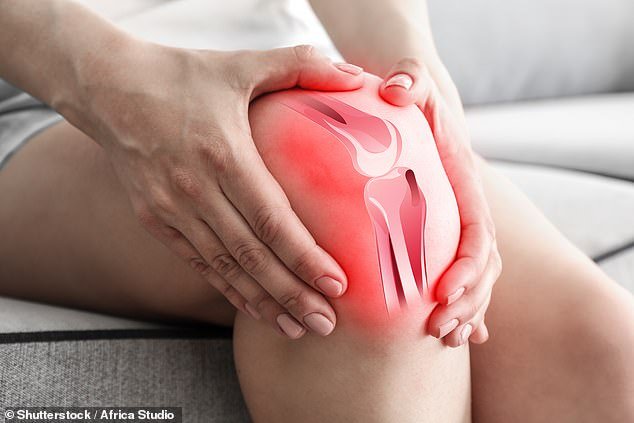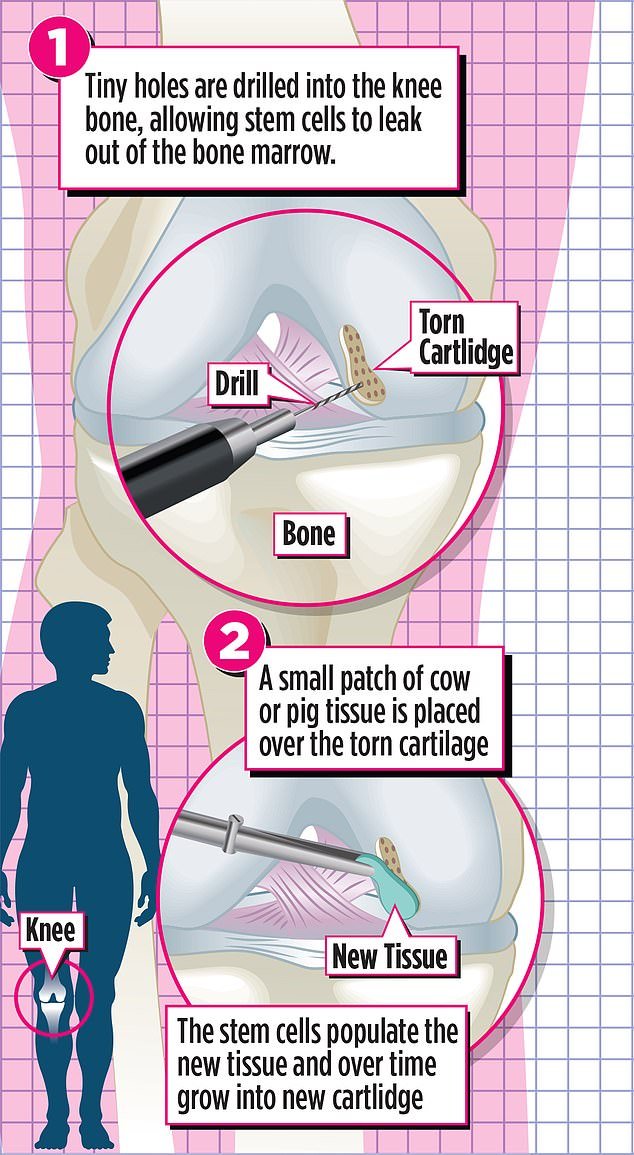Need a new knee? Now you can ‘grow your own’ after an hour-long operation on the NHS
Thousands of NHS patients plagued by agonizing knee pain will be offered ‘grow your own’ joint replacements.
The lengthy procedure to repair damage to the cartilage in the knee has been approved by the NHS spending watchdog after 20 years of research.
The technique – known as ‘single-step scaffold insertion’ – involves extracting stem cells from the patient’s problematic joint and growing them in animal tissue.
The National Institute for Health and Care Excellence (NICE) concluded that many patients with disabling knee injuries saw their mobility ‘significantly improved’ after surgery.
Around 10,000 Britons need treatment every year for torn cartilage injuries – usually in the knee. This is where the firm but flexible ‘cushion’ that prevents bones in the joint from rubbing against each other breaks, often due to heavy impacts during sporting activities, or simply by over-rotating the knee while the foot is on the ground.
Rebecca Bennett (pictured with her husband), from Somerset, was one of the first people in Britain to benefit from autologous chondrocyte implantation almost twenty years ago

Around 10,000 Britons need treatment every year for torn cartilage injuries – usually in the knee. This is where the firm but flexible ‘cushion’ that prevents bones from rubbing against each other in the joint tears, often due to heavy impacts during sporting activities (stock image)
Once cartilage is damaged, it does not repair itself.
It leads to pain, swelling and frequent locking of the joint. Many patients find that the injured knee also gives way easily, increasing the risk of dangerous falls.
Young adults who tear knee cartilage are also much more likely to develop painful osteoarthritis – where the cartilage wears out so excessively that the knee bones fuse together later in life. Some eventually need knee replacement surgery in their 40s or 50s.
This is a major operation in which the knee is cut open and the joint is replaced with a metal or plastic implant. Recovery from knee replacements takes about a year and sometimes the implant can become infected or wear out, leading to its removal. About a fifth of patients require a second joint replacement.
About twenty years ago, researchers developed an innovative solution to repair cartilage tears in the knee before they caused irreversible damage. The procedure, called autologous chondrocyte implantation, involves regrowing the cartilage in a laboratory.
Bone marrow – the soft, spongy material inside bones – is extracted from patients’ hips using a long needle. Stem cells, which have the ability to grow into healthy new cartilage, are then harvested from the bone marrow and grown in a dish. Several weeks later, the patient undergoes a second procedure in which the cells are implanted in the knee, where they continue to grow and become fully functioning cartilage.
Although effective, autologous chondrocyte implantation is very expensive; growing stem cells in a laboratory alone can cost £17,000. It also requires two invasive surgeries.
But the new one-step scaffold insertion procedure offers similar results with just one surgery. During the hour-long operation, surgeons drill small holes into the knee bone while the patient is under general anesthesia. This allows the stem cells to leak from the bone marrow.
A small piece of cow or pig tissue is then placed over the torn cartilage to serve as a kind of scaffolding for the stem cells to populate. Over the next six to twelve months, the stem cells grow into new cartilage, strengthening the knee, relieving pain and restoring movement.
The method costs a fraction of the cost of implanting autologous chondrocytes – the animal tissue scaffolds cost just £1,000 to £2,000, and does not require growing cells in a laboratory.
“This is potentially very good news,” said Ian McDermott, a knee surgeon at London Sports Orthopedics, who has performed the one-step procedure on hundreds of private patients. ‘It has an 80 percent success rate after five years and costs a fraction of the cost of current techniques.’

The major surgery in which the knee is cut open and the joint is replaced with a metal or plastic implant. Recovery from knee replacements takes about a year and sometimes the implant can become infected or wear out
However, experts claim that the procedure will not cure all patients. Studies suggest it is most effective on small cartilage tears. Patients who undergo the surgery may still need a knee replacement later in life.
However, those who have already received stem cell therapy for torn cartilage say it has changed their lives.
Rebecca Bennett from Somerset was one of the first people in Britain to benefit from autologous chondrocyte implantation almost 20 years ago.
The 43-year-old was in her late teens when a strange slip caused her knee to bend backwards, leading to years of pain. “It was the worst pain I’ve ever felt,” says Rebecca. “And I’ve had four children.”
She had damaged the cartilage in her knee. Numerous operations followed, none of which solved the problem. ‘My knee kept dislocating suddenly. The whole joint felt like a floating piece of jelly.”
Doctors warned she could end up in a wheelchair, but in 2005 she was given the chance to take part in a trial at Orpington Hospital in London, where surgeons were testing the new technique.
“As soon as I woke up I knew it was working – before I even got out of bed,” Rebecca continues. ‘It felt very different. Twenty years later, my knee is still as good as ever. It has given me my freedom back.’
